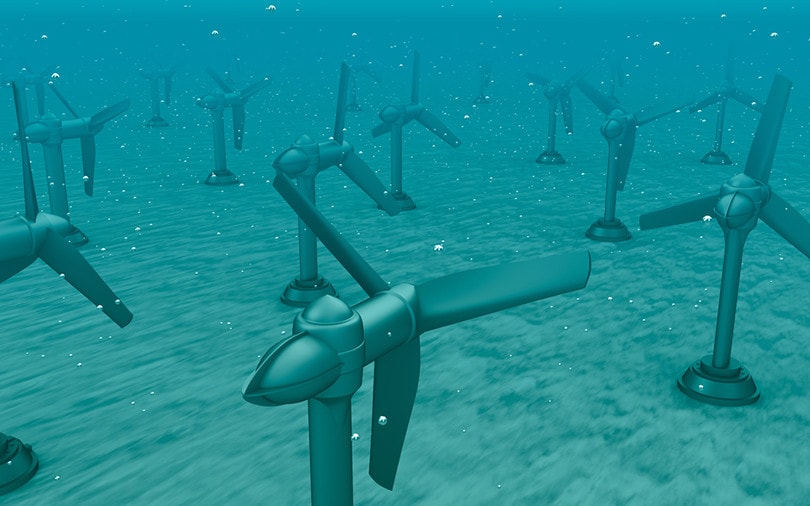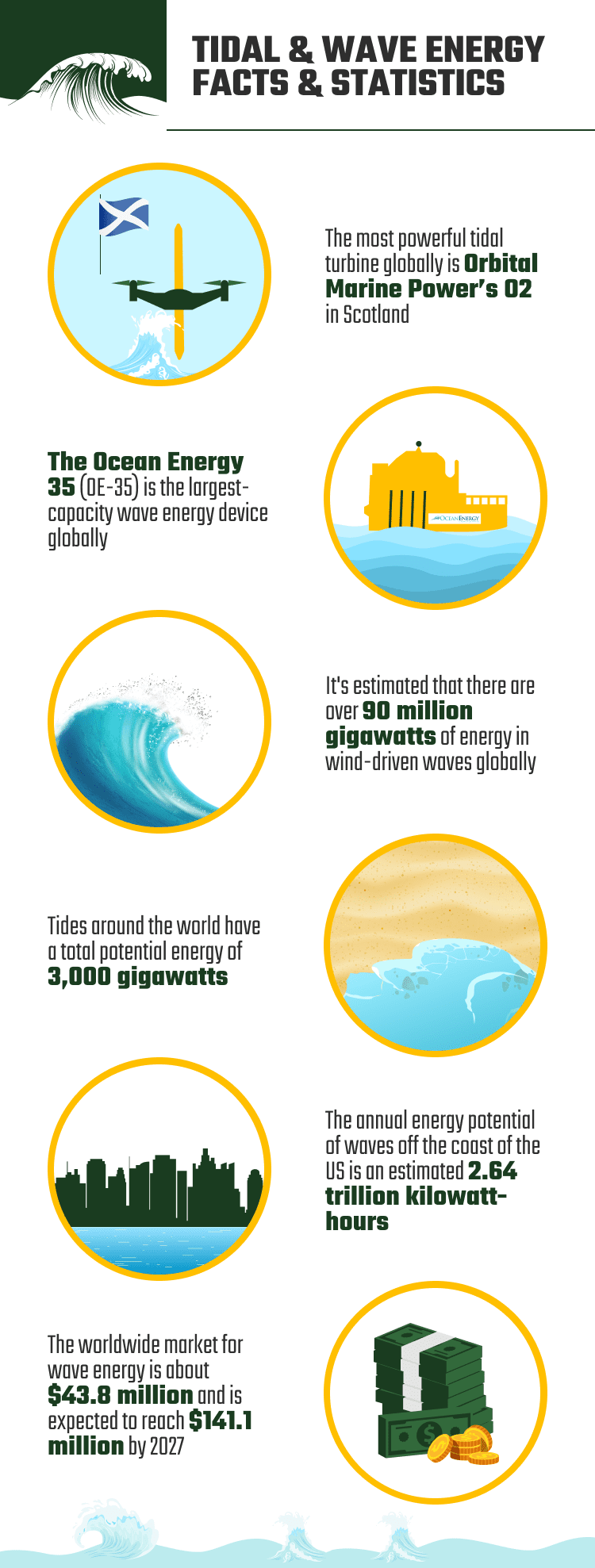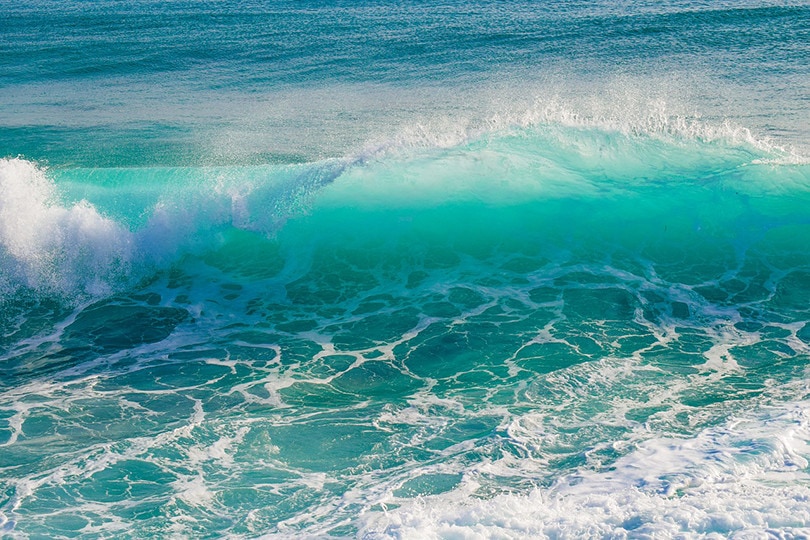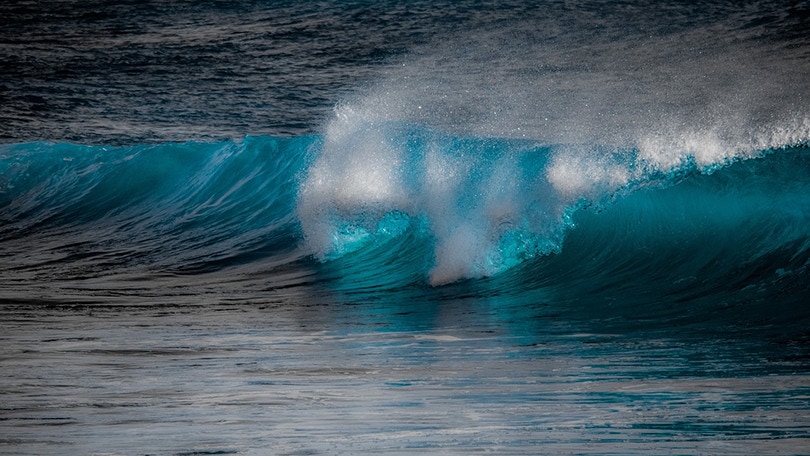10 Tidal and Wave Energy Facts and Statistics in 2025
-

- Last updated:

Note: This article’s statistics come from third-party sources and do not represent the opinions of this website.
Do you know how tidal and wave energy works? What countries are using tidal and wave energy to generate electricity? If you don’t know, you’ll find the following information more than just a series of facts.
Tidal and wave energy uses ocean currents or waves to generate electricity. A tidal generator uses the motion of ocean tides to turn turbines that generate electricity, similar to wind generation.
There are many reasons why renewable energy is becoming crucial. Given that we live on a planet with limited natural resources, there is only a set amount of fossil fuels that we could use cleanly.
The list below has facts about tidal and wave energy generation this year. It’s intended to educate energy consumers worldwide and influence power generation investment decisions.
Read on to learn more, including information on Regions with the Highest Production of Tidal and Wave Energy, Power Generated from Tidal and Wave Energy, and The Cost and Efficiency of Tidal and Wave Energy.
The 10 Tidal and Wave Energy Facts and Statistics
- The most powerful tidal turbine globally is the Orbital Marine Power’s O2 in Scotland. It has started exporting electric power to the national grid.
- The OceanEnergy 35 (US Navy test site) is the largest-capacity wave energy device globally.
- There are no commercial tidal power plants in the US.
- There are over 90 million gigawatts of energy in wind-driven waves globally.
- Tides around the world have a total energy of 3,000 gigawatts.
- The energy potential of waves every year is an estimated 2.64 trillion kilowatt-hours off the coast of the US.
- A full-size wave carpet measures 20 meters long by 10 meters wide. It can generate 500 kilowatts of power. It’s enough to provide electricity to more than 400 households.
- The worldwide market for wave energy is about $43.8 million. It’s expected to attain a high of $141.1 million by 2027.
- Tidal turbines are more costly to construct and maintain than wind turbines. But they generate more energy.
- Tidal energy converts approximately 80% of the kinetic energy into electricity. Coal converts only 30% of the energy.

 Regions with the Highest Production of Tidal and Wave Energy
Regions with the Highest Production of Tidal and Wave Energy
1. The most powerful tidal turbine globally is the Orbital Marine Power’s O2 in Scotland. It has started exporting electric power to the national grid.
(THE WEATHER NETWORK)
Orbital Marine Power’s O2 based in Scotland is the most powerful turbine worldwide, generating electricity from tidal energy. The first of these new turbines are now feeding electricity into the system at a test facility in Orkney.
The breakthrough means that tidal power has now taken its place alongside solar and wind as the third major renewable technology to be deployed.
It’s also the first time a device that converts water movement directly into electricity—known as a marine current turbine—has been successfully deployed.
2. The OceanEnergy 35 (US Navy test site) is the largest-capacity wave energy device globally.
(MARITIME EXECUTIVE)
The OceanEnergy 35 (OE-35) is a floating buoy that uses the motion of waves to generate electricity. This device is the largest-capacity wave energy device globally.
It has been installed at the US Naval Energy and Environmental Support (NAES) Test Site in Hawaii. Tests have shown that the OceanEnergy 35 can withstand a 1,000-year storm surge.
The OceanEnergy 35’s innovative design has a low visual impact. It can generate clean energy in both deep and shallow water.
3. There are no commercial tidal power plants in the US.
(EIA)
Although tidal power has been used for centuries to drive water wheels, it’s only recently that people have built full-scale power plants. Surprisingly, there are no commercial tidal power plants in the US. But there are plenty of ideas about how to make them work.
Tidal power comes from harnessing energy from the tides from oceans and large lakes. It’s a form of hydropower that converts tidal energy into electricity or other helpful forms of power.
There are two ways to achieve this: dams and barrages. Dams and barrages block the flow of water, and turbines, which extract energy from the flow of water.
 Power Generated from Tidal and Wave Energy
Power Generated from Tidal and Wave Energy

4. There are over 90 million gigawatts of energy in wind-driven waves globally.
(TAFLAB)
Many studies have shown that wind-driven ocean waves could provide a significant amount of the world’s power by 2050. Wind-driven waves can be harnessed as a source of renewable energy.
They are caused by the wind blowing over the surface of the ocean. As the wind blows, it creates surface currents that are perpendicular to the direction of the wind.
Interestingly, these wind-driven waves are not in sync with the tides. While tidal waves occur at regular intervals and have long wavelengths, wind-driven waves are created by shorter-period winds with shorter wavelengths.
5. Tides around the world have a total energy of 3,000 gigawatts.
(BRITANNICA)
The biggest tidal energy is found in large continental shelves and long coastlines. Tides can generate more than 3,000 gigawatts globally.
Tidal energy is an alternative source of power generated by the rise and fall of tides. The tides affect most of the world’s coastlines, and tidal power takes advantage of those movements to generate electricity.
The tides are the most powerful, predictable, and widely distributed renewable energy source globally. A tidal stream generator converts the energy of moving water into electricity using a turbine connected to a generator.
6. The energy potential of waves every year is an estimated 2.64 trillion kilowatt-hours off the coast of the US.
(GRIST)
The waves at the US coast can produce 2.64 trillion kilowatt-hours of electricity. It means that there’s an abundance of untapped energy floating around in the ocean. Researchers are getting better at tapping it.
Besides, the earth’s oceans are estimated to have twice as much power as all of the wind turbines globally. Tapping ocean waves can produce both electricity and freshwater. It’s not a new idea, but it is gaining ground.
7. A full-size wave carpet measures 20 meters long by 10 meters wide. It can generate 500 kilowatts of power. It’s enough to provide electricity to more than 400 households.
(SCIENCE NEWS FOR STUDENTS)
A full-size wave carpet can generate a substantial amount of power. The larger the wave carpet, the more power it generates. The power generated by the full-size wave carpet can be used in more than 400 homes.
The wave carpet aims to remove carbon dioxide from the atmosphere and sink it into the ocean floor. The project also aims to reduce marine pollution and address the increasing global demand for electricity.
The Cost and Efficiency of Tidal and Wave Energy
8. The worldwide market for wave energy is about $43.8 million. It’s expected to attain a high of $141.1 million by 2027.
(MARKET WATCH)
The global wave power market is expanding every year. It has been made possible due to the rising energy demand and increasing pressure on fossil fuel resources.
The wave power market is expected to witness significant growth over the next five years. It’s driven by factors such as increasing investment in wave power technology and technological advancements in the field.
Also, wave energy has several advantages over other renewables. These advantages include no fuel costs, an unlimited supply of power, and low carbon emissions.

9. Tidal turbines are more costly to construct and maintain than wind turbines. But they generate more energy.
(EIA)
Tidal turbines are more expensive to construct than wind turbines. It’s because they have huge parts such as blades and pillars. The cost of constructing these parts is almost three times greater than the cost of constructing parts for wind turbines.
Also, the maintenance cost of tidal turbines is higher than that of wind turbines. Tidal turbines must be fixed when they break down. It requires a lot of material and labor.
Furthermore, each time there is an incident or breakdown with one of these machines, it costs thousands of dollars to fix it. Luckily, tidal turbines generate more electricity than wind turbines.
10. Tidal energy converts approximately 80% of the kinetic energy into electricity. Coal converts only 30% of the energy.
(STORY MAPS)
When it comes to power generation, tidal energy is one the most efficient resources in use today. It’s because tidal energy converts a massive amount of its kinetic energy into electricity while coal converts a small percentage of its kinetic energy.
However, there are many challenges associated with capturing tidal energy to convert it into usable electricity. The main difficulty is that tidal stream generators (or tidal turbines) must be anchored deep enough in the ocean. This way, they overcome drags from water flow and Coriolis Effect forces acting on them when generating power.
Frequently Asked Questions
How does tidal energy work?
Tidal energy is energy derived from tidal flows. It’s derived from the periodic rise and fall of sea levels. It’s caused by the invisible force of gravity exerted by the moon and sun on earth’s oceans.
The gravitational force of the sun and the moon causes two high tides and two low tides every day. Because the moon is smaller than the sun, its gravitational pull is not strong.
So, it takes about 12 hours for a high tide to occur after a low tide and another 12 hours for a high tide to follow a low tide. It results in two high and low tides every 24 hours.
Essentially, tidal energy harnesses this energy to generate electricity. The idea is to place turbines in bodies of water near where these bulges occur. When these turbines are in place, they can harness this energy and convert it into electricity for us to use at home and in our businesses.
(ACTION RENEWABLES)
How does tidal energy affect wildlife?
All forms of hydroelectricity have several environmental impacts. To mitigate these impacts, proponents of tidal energy must ensure that they follow environmental regulations.
The greatest impact of tidal energy on wildlife is habitat loss. Tidal turbines affect more than just marine life. Terrestrial animals also depend on tidal flats for living space.
Tidal turbines can displace birds, mammals, and other species from their natural habitats. If animals are displaced, they may not find food or a place to breed or lay eggs in their new surroundings. It can lead to population decline or even extinction in some cases.
(SEA GRANT)
How are tidal and wave energy helping to combat climate change?
Tidal and wave power are still in their infancy due to widespread use for generating electricity for homes and businesses. But there are several reasons why it’s important to continue developing these sources of energy.
They’re clean power options, meaning there are no emissions such as carbon dioxide. This helps combat climate change in a great way.
People have been using energy sources such as coal and oil for a long time. Although these energy sources are useful, they’ve left behind a giant carbon footprint.
Tidal and wave power are examples of renewable energy sources that can fight climate change.
(CLIMATE CHANGE)
What tidal range is required for tidal energy?
The difference in water level between high tide and low tide is the tidal range. It’s usually a few feet in many locations. But it can be as much as ten feet or more in a few locations.
The tidal range depends on the size of the tide and the length of the tidal period. The longer the period, the greater the tidal range.
The size of the tidal range has a strong influence on the amount of tidal power available in a location. Tides are more powerful in areas with steeply sloping coastlines with deep channels between islands that funnel water into narrow inlets.
(EIA)
What increases wave energy?
Wave energy is a natural source of power. Waves are formed by wind blowing over the water surface. As the waves move toward the shore, they break and create turbulence near the surface. Wave energy is contained in this turbulence.
The distance between the wave crest and trough matters because that determines how much water is being pushed up. The higher the height difference, the more potential energy there is.
The amplitude or height of the waves affects how much water is pushing against something.
The frequency or period of waves matters because it affects the length of time between consecutive crests. The longer the period, the more energy there is in each wave cycle.
Wave direction also affects how big a surface area gets hit by each cycle of waves. If you’re trying to capture a large amount of wave energy, it makes sense to place your system where high-energy waves are moving toward a coastline rather than away from it.
(SCIENCE LEARN)
Which is better between tidal and wave energy?
Both tidal and wave energy are great and clean sources of electricity. Both are renewable resources generated naturally.
The power of the tides generates electricity, whereas wave energy uses the power from ocean waves.
Tides are caused by the moon and the sun’s gravitational pull. It produces two high and low tides every day. Wave energy is generated from ocean waves, which are caused by wind or other weather events.
(DIFFERENCE BETWEEN)
Advantages of Tidal and Wave Energy
Tidal energy is an electricity-generating technology that converts the movement of tides into mechanical power, which can be subsequently converted into electrical power. Wave power is also an alternative source of renewable energy, which also uses tides and waves to generate electricity.
There are many differences between tidal and wave power. The main one is that tidal power uses the motion of the ocean, whereas wave power uses the motion of the waves in the water. This is a basic difference between tidal and wave energy, as others are more crucial to understand.
Tidal power relies on the tides in the ocean to move underwater turbines. These turbines are connected to generators, which turn this movement into electricity. The main advantage of this is that it can be done 24 hours a day, every day of the year.
The disadvantage is that there is only a limited number of places to use tidal power. It’s because there has to be an incoming and outgoing tide each day for it to work effectively.
The main advantage of wave energy is that you can change its form into electricity using turbines. These turbines must be mounted on floating platforms. This way, they’ll not interfere with the natural flow of water in waves or tides. Another advantage is that you can use wave energy anywhere there are waves or tides, eliminating the need for a specific location.
There are other advantages and disadvantages to both tidal and wave energy systems. But knowing these basic ones will help you understand how they work and their setbacks.
Conclusion
As you can see, there’s a lot of promise behind tidal and wave energy. While some hurdles still need to be addressed, these clean and renewable sources of power may eventually become viable options for many countries.
Tides and waves are unmanageable natural resources, but they can be utilized effectively. People are working to harness the power of these two renewable sources of energy. Tidal and wave energy are interesting topics for people who love the ocean!
The two can help conserve the environment and lower our energy costs. This way, we can survive any economic crises that may be on our way.
Featured Image Credit: Alex Mit, Pixabay
Contents

